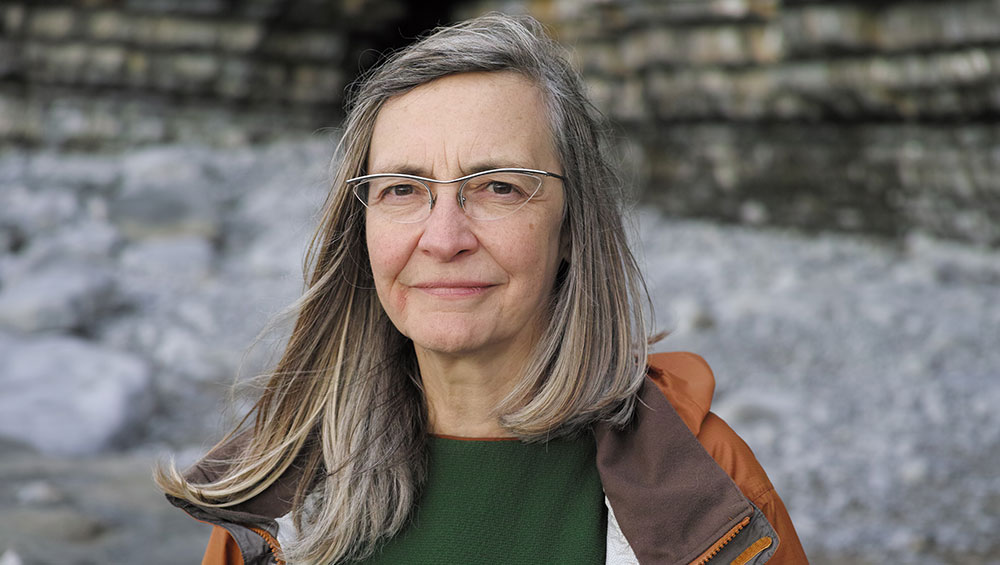
Jacqueline Poncelet. Photo: Anthony Stokes.
by VERONICA SIMPSON
Embrace the unexpected could well be the motto of Jacqueline Poncelet (b1947, Belgium). She set off for art school in Wolverhampton intending to study textiles, but ended up choosing ceramics. Although her early pieces of pale, bone china won acclaim, she was soon exploding any notions of what people might expect from her, or her materials. Throughout her 35-year career, she has remained a major figure on the international ceramics scene. But her restless creativity has led her down many different paths, revealing new approaches to traditional materials and techniques, but always with that hunger to push pattern and form beyond what might normally be seen as possible, whether in weaving, sculpture, watercolour, wallpaper, carpet or oil painting.
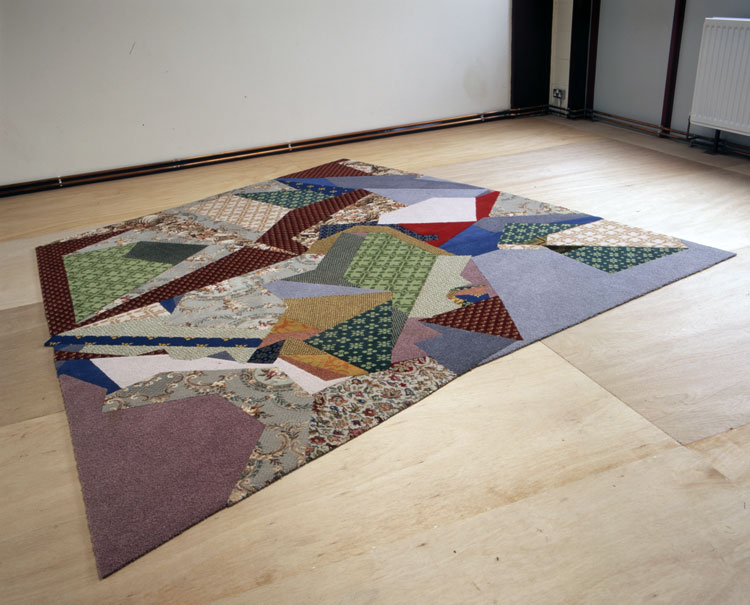
Jacqueline Poncelet. Spread, 1994. Carpet, 245 x 328 cm. Arts Council Collection. Photo: David Ward.
In the last two decades she has scaled up her work to animate buildings inside and out, from an early commission to create a mosaic dado for an Edinburgh festival venue to her landmark Wrapper work for Transport for London’s Art on the Underground: adorning a cluster of buildings near Edgware Road tube station, a family of tiles enlivens this previously dull piece of streetscape, making tube passengers’ journeys just that little bit more enjoyable.
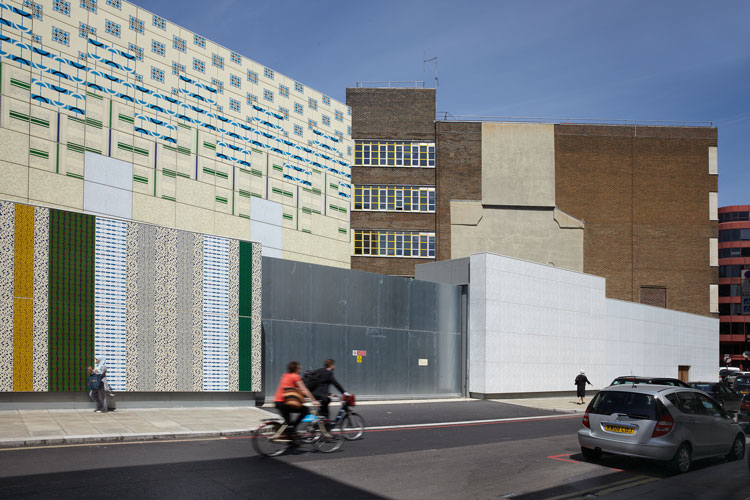
Jacqueline Poncelet. Wrapper work for Transport for London’s Art on the Underground, Chapel Street, near Edgware Road tube station. Photo: Peter White.
Poncelet has said she revels in the mess of cities – especially New York, where she spent an extremely fruitful year on a funded fellowship in the late 1970s. There, she says: “I saw grids with mad patterns in them - architecture subverted by nature. Madness everywhere. At that point down in SoHo everything was covered in pattern. If you looked in shops, they had stamped metal ceilings. Nothing was quite what you would imagine New York to be. It was so thrilling. It gave me the possibility to make very different work and to start covering things with pattern.”
In a 2014 Slade Art School lecture, she talked about applying her system of pattern-making to the exterior of the humanities building at Queen Mary University of London. “The pattern is made out of photographs of piles and piles of books. When on the building, they take on the appearance of huge, fat, great big columns. You have this relationship of learning and architecture, and the way brain and eye work together.”
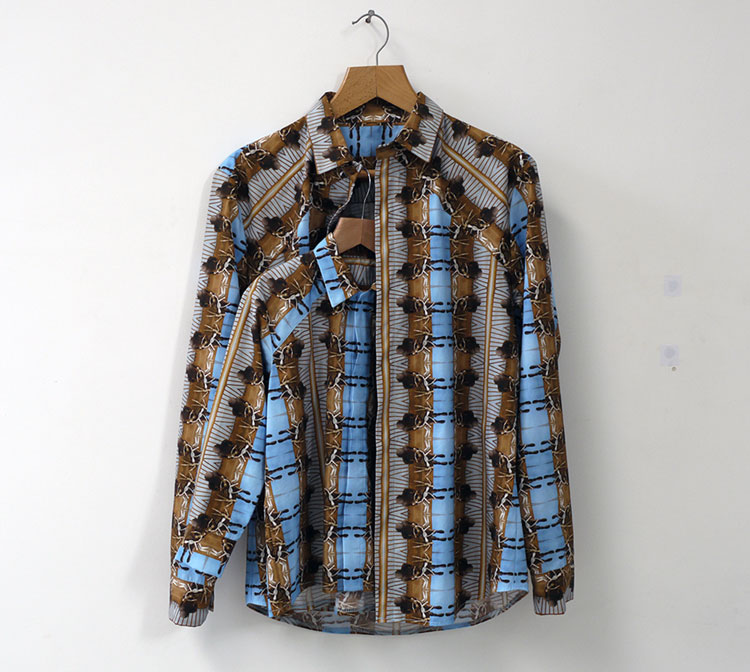
Jacqueline Poncelet. Man and boy. Printed textiles. Photo: Anthony Stokes.
Landscapes endlessly inspire her – urban and wild, large and small, interior and exterior - and she draws inspiration from her two bases: her studio in a remote part of rural south Wales and her south-east London base, in Peckham.
Poncelet studied at Wolverhampton College of Art and the Royal College of Art and has gone on to be an influential teacher and lecturer at the Slade 2002-06, Goldsmiths, Farnham and the Royal College of Art. Her solo exhibitions include The Whitechapel Art gallery, London (1985), Kettle’s Yard, Cambridge (1988); The Decorative Sublime at the Museum of Modern Art, Oxford (1995); and Watching Trees Lounge at Swansea Museum and Art Gallery, Wales (2006). She is represented in important public collections including the Tate and the V&A in London, the Stedelijk Museum in Amsterdam, the National Museum of Stockholm, the Museum of Modern Art, New York, and the National Museum of Victoria, Australia.
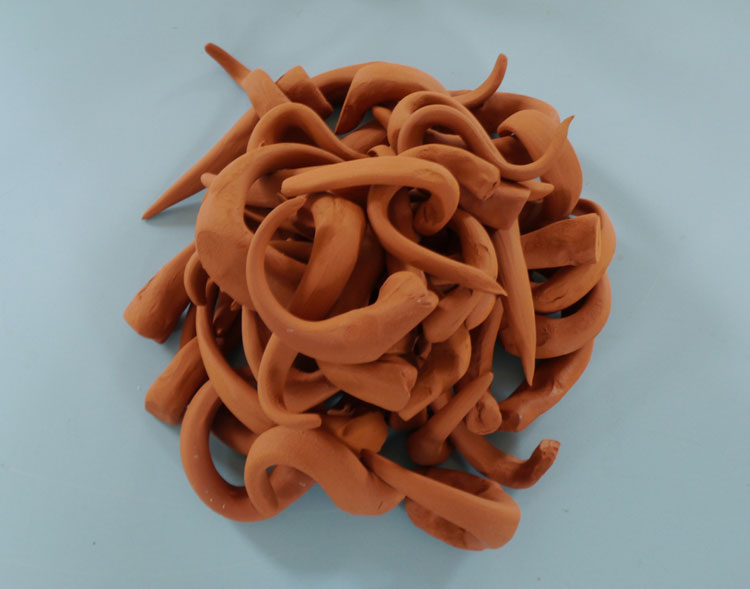
Jacqueline Poncelet. Mass, 2018. 40 x 40 cm.
The forthcoming UK survey show of her work, Now and Then, at the New Art Centre at Salisbury in Wiltshire, brings together pieces from the last 35 years. Curated by Sarah Griffin, it is the latest offering in the gallery’s decade-long annual series on materials and making. Alongside her own work, Poncelet has curated a small exhibition featuring work by her friends and peers, called: the other side of the coin. It features new and existing work by Phyllida Barlow, Laura Ford, Carol McNicoll, Lisa Milroy and Alison Wilding.
Veronica Simpson: The prospect of this New Art Centre show must have provided a welcome focus and momentum over this strange summer of 2020. Did this – and the sense of quiet and downtime of lockdown - give you licence to explore some new areas?
Jacqueline Poncelet: I gave myself that (licence) a couple of years ago after the Anni Albers show at Tate Modern. I’d been interested in her for a long time, but I saw that show and it was so inspiring. I have always had this huge love for textiles, and because I’m getting older, I thought: if I don’t do this now, I’m never going to do it. Being in Wales, I found somebody to help me thread up a loom, so I had already started weaving. When they announced lockdown, I quickly ordered a slightly bigger loom, so I had two looms to work with. I’m really interested in the history of weaving in Wales and we have a collection of shawls and Welsh blankets. So, I was weaving in lockdown. As part of the show, I also got these wonderful weavers in Bristol to weave me some different blankets. There’s something in Wales called a narrow-loom blanket. They wove them in two parts and then sewed them together down the middle. The looms had to be narrow because people kept their looms at home, so they needed a bit of space to walk around them: they are about half the width of a double bed, so still quite big. The whole thing chimes with this idea I’m interested in - what I call the domestic landscape. I like the idea that every part of a home has its own feeling, and this idea of the Welsh landscape being translated into a blanket, and then you have a part of the landscape on your bed. I’m one of those people who likes to lie in bed of a morning thinking, and I like that idea that you’re looking at something that becomes part of your thinking.
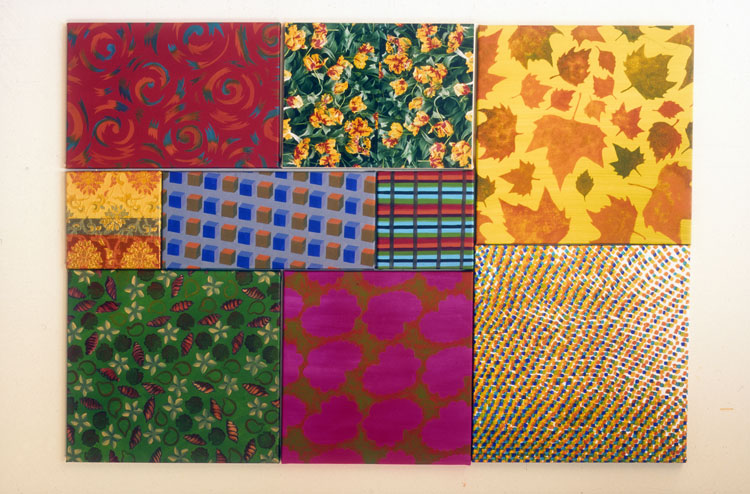
Jacqueline Poncelet. Leaf, 1995. Composite oil painting with fabric and photography.
VS: You have worked in so many different media and on so many different scales, when you conjure work in your mind’s eye, at what scale do you see it?
JP: I am always surprised by my understanding of scale - especially when I think back to what I began making, which was tiny pots. I don’t know where my interest in architecture began, but I put it down to growing up in the Midlands in the 50s and 60s when they were reconfiguring cities and absolutely wrecking them. Why I would become obsessed with that I don’t know, but I did. I think in the back of my mind I might have been making small pots, but I was also spending a lot of time looking at architecture.
VS: And your experience of living in New York played its part.
JP: Yes, because I fed off that for years. I think it might come from having that start in life where there were two such different sides to my experience: the first four years of my life were spent in Belgium, which is aesthetically so different. Then we came to England to live, but every summer we were going back to Belgium and having those contrasts, not having the same interior as friends had in school, and not having the same food. As a child, I was trying to reconcile my experiences, because children are just so deeply conventional, they just want to fit in and be the same.
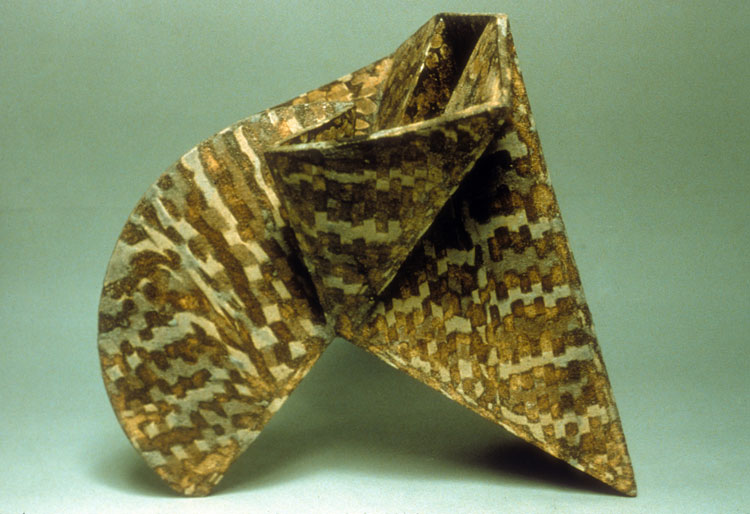
Jacqueline Poncelet. New York pot 1979. 30 x 20 cm. © the artist.
Going to art college was like discovering where I belonged, even though it took me a while to find my feet. Art school then was inspired by the Bauhaus and riddled with rules. They have become part of my way of looking at things, even though they were too prescriptive for me. When you discover the rules of other cultures are so different - Persian art, Persian ceramics, Japanese prints – then, suddenly, you are able to piece your own rules together, almost piece yourself together in your own right, and develop your ability to explain to other people why you’ve made your choices.
VS: I guess New York introduced a whole new set of rules – or a way of exploding them.
JP: We might talk now about how grey England was in the 70s; well, New York was frightening. It was a dangerous place. But it was so exciting. And the art world was small. You could go to an opening and Andy Warhol was there, and you thought nothing of it. On Thursdays, you could go to any of the New York galleries and show your work. There was a kind of openness. In life, to experience something is to know it’s a possibility, whether positive or negative.
VS: Was the ceramics scene much more open to experiment in New York in the 70s?
JP: There was a funny category for us in the UK – the Crafts Council called us “artist craftsmen”. But it was a very exciting time for ceramics, and we really didn’t care about titles: we were just getting on with our work. And in New York, the galleries were showing people who worked in clay. There wasn’t that British preoccupation with categorising people.
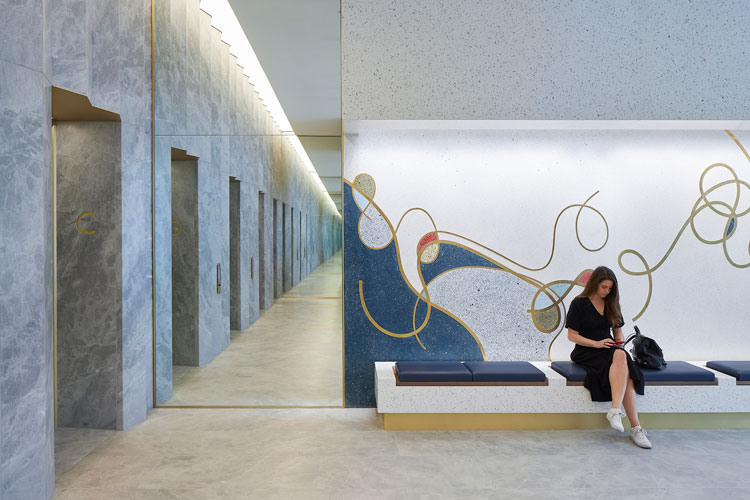
The Views, The Marq terrazzo. Architects Rolfe Judd, 2019. Photo © Hufton+Crow.
VS: I would love to know where you made that leap from fine art ceramics and sculpture to buildings.
JP: That was through an architect who was putting together a group of artists to do different projects for the Hub in Edinburgh, the old building that is home to the festival. I created terrazzo dados for the cafe, the shop and the corridor, and it was interesting because I did them with complete freedom. Then I started to receive more of those commissions. After a while, I got confused between myself as an artist and as a designer. They are different animals. Gradually, I learned to let go of my good-girl tendency. It’s very difficult when you get these projects not to be the good girl and to fit around all the constraints. And it is very difficult because you do have to take on the constraints of something being able to be built. So, there will always be something that’s saying: you can’t do that. But you have to be very careful not to let go of the essence of your work. It’s a balancing act.
.jpg)
Jacqueline Poncelet. Enamel notice boards for Sunshine House (Child development unit).
VS: I would imagine the Transport for London commission was an absolute high point on that front.
JP: I’m afraid it is. Will I ever get carte blanche on a building again? There was no architect to fit around. I only had to deal with the people delivering it and Tamsin (Dillon, the director of the pioneering Art on the Underground) was absolutely brilliant.
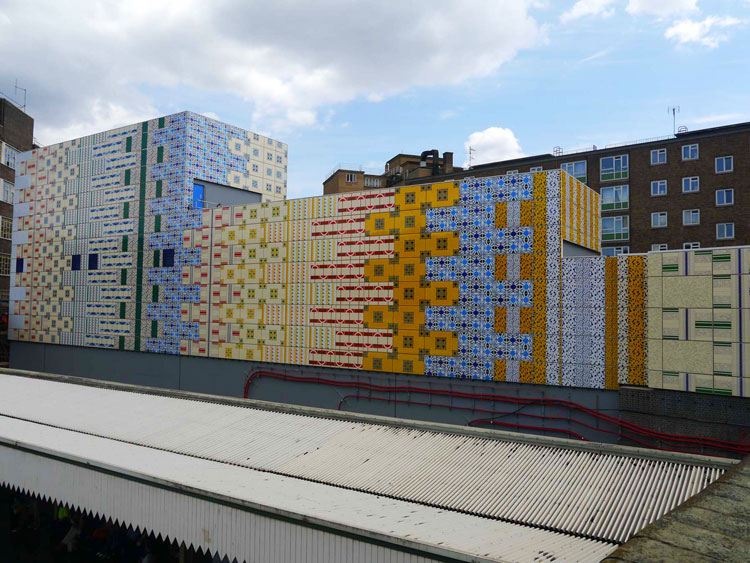
Jacqueline Poncelet. Wrapper work for Transport for London’s Art on the Underground, Chapel Street, near Edgware Road tube station. Photo: the artist.
VS: You have remained a very popular choice for architects or developers looking for a signature piece to enliven or enrich their projects. The last time we spoke, you were working on something for the Crown Estate, in London.
JP: Yes, it’s on the corner of Duke and Jermyn Street. It’s the first time I’ve worked within a set of set spatial and material conventions. That’s been interesting. There is a corner window made from carved Portland stone, which I have put gilding on, and I have created a gate made of patinated bronze. And there’s a big terrazzo drawing in the reception area. So, yes, it was really interesting.
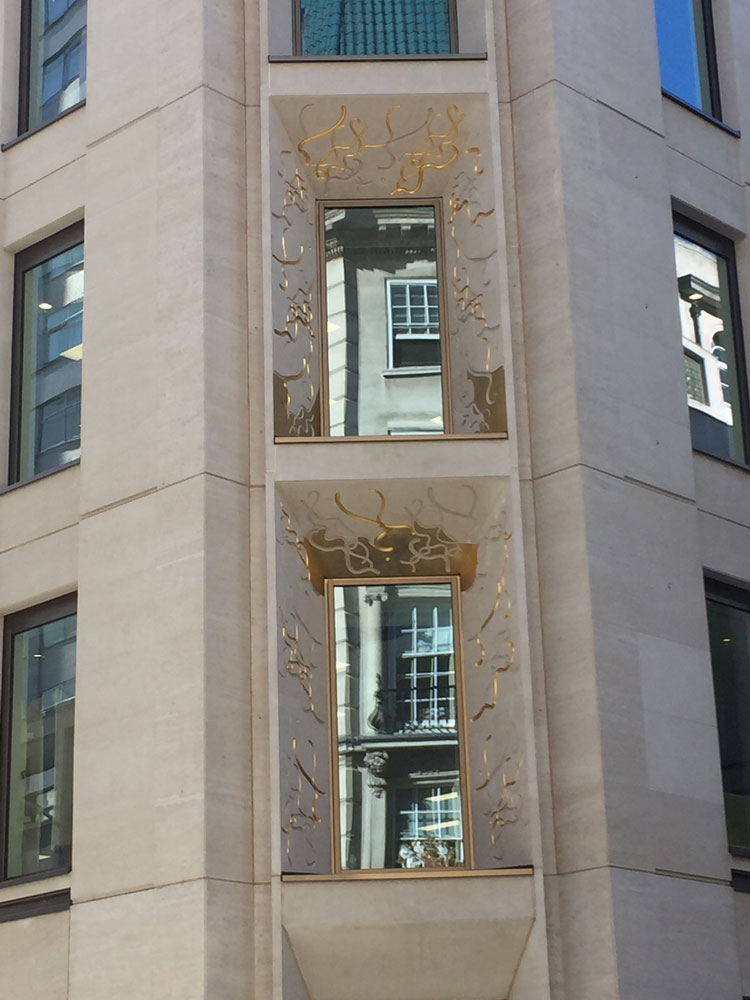
Jacqueline Poncelet. Gilded window reveals, London.
VS: What other works from the last 35 years are you looking forward to showing – and seeing - at the New Art Centre?
JP: The blankets, which I’ve mentioned. And there are some watercolour paintings I started making in the last 10 years. Working on such huge things has made me enjoy work on very tiny things. What I think is really interesting about my work is that, when I look at it, I know that’s the person I was, but not who I am now. You can put a paintbrush in my hand and I won’t make those paintings again. But there is some new clay work. At the start of lockdown, I bought some clay, and although I thought I was never really a proper potter, I started to make thumb pots and discovered they were really sophisticated things to make and I found I had an absolute facility for them. But I’m curious about why I never learned to throw despite being taught how to throw in my early years. I think it’s because there was nothing I wanted to make. When you know what you want from that technique, that’s when you put your knowledge to work. Back then, I loved working with plaster and moulds and model-making and so my ceramics had been based on industrial techniques. It was interesting to rediscover clay in this very physical way.
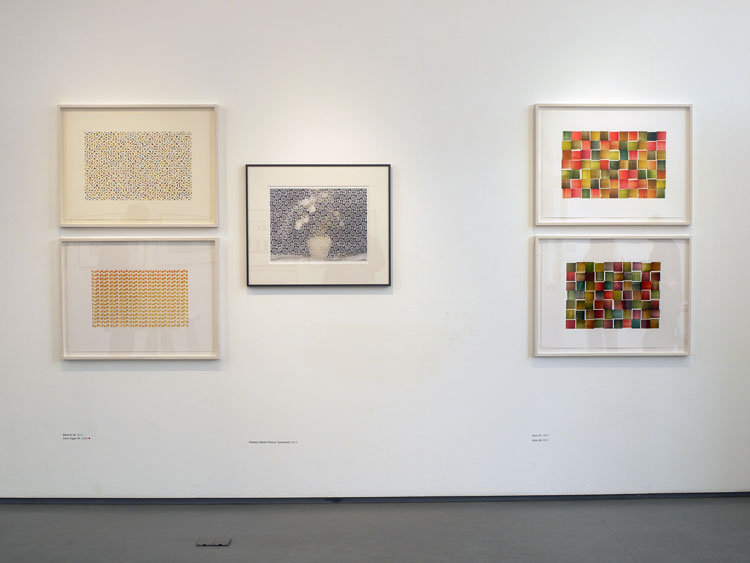
Jacqueline Poncelet. Watercolours. Bryn Ogwr exhibition with Anthony Stokes. Photo: Anthony Stokes.
VS: Are there any new ceramic pieces?
JP: My studio in Wales is above a river. Because of the very rapid changes in water level, it can go from a benign stream to a torrent. I started to make these clay twists, and they were something to do with the power of the water. Also, there are memories of certain things that have obsessed me all my life, and one is that my Belgian grandmother used to wash her steps every day. She had a way of wringing out the cloth. You know when you’re a child you become obsessed with these things. So, I have been doing this thing of strangling the clay, creating these large almost handles – pulling the clay, using that technique that you’d use for creating a handle.
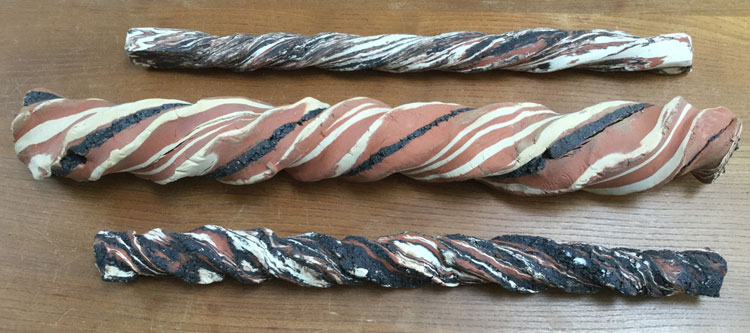
Jacqueline Poncelet. Three clay twists, 2018. 50 cm long.
VS: Is it the first time that such a large range of your work has been assembled?
JP: Yes, there’s a joke that I’m a group show all on my own.
VS: As an artist so sensitive to landscape, do you feel your relationship to your chosen settings has changed over the years?
JP: Something interesting has happened in my relationship with Wales. To begin with, there was a kind of romanticism with the place, because of this extraordinary love affair I was having with colour. Then, of course, the place stops being an abstract and becomes a real place you have to negotiate, and then you can no longer say with confidence: this is how it is. You know that you’re being influenced by it, but not in the way that you were when you were starry-eyed and fresh. I also know that without being aware of it, I’m all the time thinking about these contrasts between being in London and being in Wales. Where we are in Wales, we’re very near the coast – it’s only 10 miles away. Very few people go there. It’s the most wonderful Jurassic coastline. There are slabs of stone going out into the sea, and the patterns of waves have been eroded into them. I can say with some certainty that you never go there and find the same place. I know that has a positive influence on me.
VS: Does it reignite your excitement for looking?
JP: Yes, but it also gives me the opportunity to deal with more uncertainty – that’s the only way I can say it - to make work.
VS: Do you mean that sense of ease with discontinuity?
JP: Yes, it’s about saying uncertainty is all right; it gives us an opportunity to look again and think again. The thing that happens is you think you know what you’re doing, and then four or five years later you find out what you were doing. It’s a bit like that. You have to think you’re doing one thing in order to get it done.
• Jacqueline Poncelet: Now and Then is at the New Art Centre, Salisbury, from 21 September 2020 to 9 January 2021.